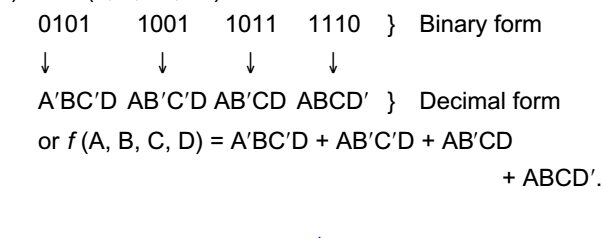Advanced Microprocessors
- The dual of Boolean theorem x (y + z) = xy + xz is—
-
View Hint View Answer Discuss in Forum
Dual means sum terms represents product terms and product term represent sum terms. From the given Boolean theorem the dual of x (y + z) will be x + y.z. Which may be represented as (x + y) (x + z). Hence alternative (C) is the correct answer.
Correct Option: C
Dual means sum terms represents product terms and product term represent sum terms. From the given Boolean theorem the dual of x (y + z) will be x + y.z. Which may be represented as (x + y) (x + z). Hence alternative (C) is the correct answer.
- If a three variable switching function is expressed as the product of maxterms by—
f (A, B, C) = ΠM (0, 3, 5, 6)
then it can also be expressed as the sum of minterms by—
-
View Hint View Answer Discuss in Forum
Apply the concept used in above problem.
Correct Option: C
Apply the concept used in above problem.
- The other canonical form of
f (A, B, C) = Σ m (0, 1, 5, 7) is—
-
View Hint View Answer Discuss in Forum
Other canonical form means product of sum
POS, f (A, B, C) = π M (2, 3, 4, 6)
Hence alternative (A) is the correct answer.Correct Option: A
Other canonical form means product of sum
POS, f (A, B, C) = π M (2, 3, 4, 6)
Hence alternative (A) is the correct answer.
- The switching function
f (A, B, C) = (A + B′ + C) (A′ + B′ + C) (A + B′ + C′)
can also be written as—
-
View Hint View Answer Discuss in Forum
Question given in maxterm or POS form and options are given in minterm form. So, first we have to convert POS into SOP form.
(maxterm)′ = minterm
Leaving 2, 6, 3 rest are maxterm decimal equivalent
π M (A + B′ + C) (A′ + B′ + C) (A + B′ + C′)
= Σ m (0, 1, 4, 5, 7)
Hence alternative (B) is the correct answer.Correct Option: B
Question given in maxterm or POS form and options are given in minterm form. So, first we have to convert POS into SOP form.
(maxterm)′ = minterm
Leaving 2, 6, 3 rest are maxterm decimal equivalent
π M (A + B′ + C) (A′ + B′ + C) (A + B′ + C′)
= Σ m (0, 1, 4, 5, 7)
Hence alternative (B) is the correct answer.
- The switching function f (A, B, C, D) = Σ m (5, 9, 11, 14) can written as—
-
View Hint View Answer Discuss in Forum
Σ m (5, 9, 11, 14)

Hence alternative (A) is the correct answer.Correct Option: A
Σ m (5, 9, 11, 14)

Hence alternative (A) is the correct answer.

